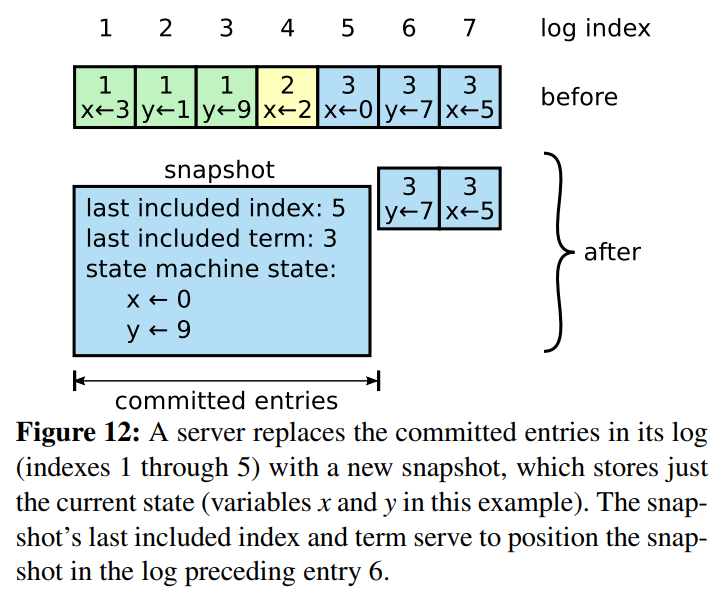题目:http://nil.csail.mit.edu/6.824/2022/labs/lab-raft.html
Part 2A: Leader election
为了防止所有节点同时发起选举形成活锁,节点的超时时间需要带有随机性,论文中推荐150~300ms:
We recommend using a conservative election timeout such as 150–300ms; such timeouts are unlikely to cause unnecessary leader changes and will still provide good availability.
优化思考:投了拒绝票的server,需要reset election timer吗?如果不重置,可能出现刚选举出一个新leader,投了拒绝票的follower又发起一次新的选举。
Part 2B: Log replication
在没有新请求进来的情况下,拥有较大term的leader无法提交较小term的entry,导致最后一条entry始终无法提交。解决方法定期向日志中append一个特殊的entry,这条entry的command要是int类型,否则某些用例过不了。
在leader当选时需要触发一个空的entry,来迫使拥有更小term并且未提交的entry被提交。这一点在2021年视频课程的lecture 11 1:18:33中也讲到了。但实验中某些用例会通不过,例如TestRPCBytes2B,只能通过定期写入特殊日志的方式来解决这个问题。
Part 2C: Persistence
TestUnreliableChurn2C遇到过一个请求乱序引起的问题,出错概率在万分之一。
- Leader复制日志下标为
[2, 3, 4]的entries到follower - Follower提交了这几个entries
- Follower收到了一个过期的AppendEntries请求,请求中的entries为
[2, 3] - Follower进行一致性校验时,把
4给截掉了 - 下一次leader election,这个follower投了错误的选票,导致没有最新entry的server当选为leader
解决方法:在执行一致性检查的时候,已经commit的entry需要跳过,不能被截断。
Part 2D: Log compaction
死锁问题
由于测试框架是循环从applyCh中取出消息,在for循环内部调用Snapshot接口进行日志压缩,因此向applyCh发消息不能在锁中完成,否则会形成下面的死锁:
| 线程1 | 线程2 |
|---|---|
| mu.Lock() | for m := range applyCh |
| applyCh <- msg ---- 等待 | Snapshot接口中的mu.Lock() ---- 等待 |
线程1等待线程2从channel中取走消息,线程2等待线程1释放mutex。解决方法是创建一个带长度的临时channel,apply时只是将ApplyMsg放入临时channel,然后开一个独立的协程无锁的提交这些日志:
func (rf *Raft) applier() {
for msg := range rf.tmpApplyCh {
rf.applyCh <- msg // 无锁写入channel
}
}
日志压缩
由于快照是由每个节点自由控制完成的,没有一个统一的快照或下标,因此,日志压缩后,保留下来的entry的下标是不能轻易变动的,否则日志复制会产生错乱。例如节点A将X复制B,并告知节点B这条日志的下标为1,但对于节点B来说,由于可能还未执行日志压缩,X应该存储在下标为10的位置而不是1的位置。因此,正是由于压缩行为是各节点自己控制的,所以2D部分的核心就是如何维护各自的日志下标。
这里的实现采用了逻辑下标与物理下标相结合的方式。逻辑下标表示如果没有发生日志压缩,日志应该所处的位置,物理下标就是日志当前真正所处的位置,通过物理下标能实际获得该entry。逻辑下标和物理下标之间可以相互转换,规则为:
逻辑下标 - lastIncludedIndex = 物理下标
节点之间传播的是逻辑下标,节点内部和下标相关的状态,例如commitIndex、lastApplied等也都使用逻辑下标,这样带来的好处是原先的RPC相关代码不用改动。只有真正要读写日志时,才将逻辑下标映射到物理下标。例如要获取日志中最后一个entry的逻辑下标和term:
func (rf *Raft) lastEntryInfo() (index int, term int) {
lastLogIndex := rf.lastEntryLogicIndex()
lastLogTerm := rf.getEntry(lastLogIndex).Term
if lastLogTerm == 0 {
// 最后一条entry已经被放进snapshot了
lastLogTerm = rf.lastIncludedTerm
}
return lastLogIndex, lastLogTerm
}
// 计算得到日志的逻辑长度
func (rf *Raft) logLogicSize() int {
return len(rf.log) + rf.lastIncludedIndex
}
// 计算得到最后一个entry的逻辑下标
func (rf *Raft) lastEntryLogicIndex() int {
return rf.logLogicSize() - 1
}
持久化问题
Lab说明中有一个hint:
Hint: Even when the log is trimmed, your implemention still needs to properly send the term and index of the entry prior to new entries in
AppendEntriesRPCs; this may require saving and referencing the latest snapshot'slastIncludedTerm/lastIncludedIndex(consider whether this should be persisted).
这是关于lastIncludedTerm/lastIncludedIndex持久化问题,有两种实现方式:
- 持久化到state中
- 持久化到snapshot中
论文中是将这两者保存到了snapshot中:

但是这里有个问题,就是snapshot是由上层service来构造的,上层不保证会把这两个字段包含进来。例如测试框架就没有把lastIncludedTerm包含进来:
w := new(bytes.Buffer)
e := labgob.NewEncoder(w)
e.Encode(m.CommandIndex) // 这个lastIncludedIndex用于InstallSnapshot时候的校验
var xlog []interface{}
for j := 0; j <= m.CommandIndex; j++ {
xlog = append(xlog, cfg.logs[i][j])
}
e.Encode(xlog)
rf.Snapshot(m.CommandIndex, w.Bytes())
因此,我采用了第一种实现方式,将它们持久化到state中,这样即使上层service构建snapshot时不包含lastIncludedTerm/lastIncludedIndex,raft层自身也能从持久化中恢复出来。
总结:Raft层不感知snapshot具体格式,由service层解析。
标签:6.824,下标,Lab,rf,snapshot,entry,日志,节点 From: https://www.cnblogs.com/oyld/p/17124941.html